
4
WSP 10
This ship, with a 15m length and a 3.9m beam, was
built at the Bodan Shipyard in Kressborn, Germany,
and delivered on 30th June 1989 to the Harbour
Police in Bayern. The ship is stationed at Passau on
the Danube.
Of the regional boat type, the WSP 10 has 300 HP
MAN diesel engines, which give an spproximate
speed of 40 kph. When on normal duty, the boat
has a crew of two and various equipment, including
radar, echo sounder, automatic pilot, 4 radios and an
explosion safeguard. The boat and its crew have a
wide variety of tasks, such as surveillance, especially
in connection with dangerous cargoes, and normal
police duties. Another important task is environmental
surveillance.
The WSP 10 patrols an area stretching from the
Austrian border and roughly 80 km upstream.
FIG.1: HULL
When working in plastic, there are a few easy rules
you should remember. When gluing various materials
together, for instance, the following types of cement
can be recommended:
For gluing plastic to wood use contact cement.
Fitting, etc. can be attached with quick cement or
two-component cement, and plastic can be glued to
plastic with contact or plastic cement. Avoid using
excessive quantities of cement, as some types are
very powerful and can attack plastics. Clean the hull
thoroughly before positioning the fender strips and
before varnishing. Ordinary detergent is effective for
this purpose. Glued areas can be sanded lightly, for
example with steel wool.
The various marker lines have been marked with
white lines in order to indicate clearly where the
waterline, fender strips, etc. areto be placed. The
main drawing shows where and how to cut away
excess material. Before cutting out the hull, use a
pencil to reinforce marker lines. To cut out the hull,
deck and cabin, use a sharp hobby knife, pressing
gently and repeating several times until the material
can be broken off when gently bent. Carry out this
procedure very carefully.
When cutting out the hull, note that there is a small
notch in the rst third of the hull.
FIG.2: REINFORCEMENT STRIPS
As can be seen, the foreship is equopped with
reinforcement strip no. 1, upon which the deck is to be
positioned. Make sure that the hull has been smoothly
sanded on all cut edges; then glue on the strip with
1.5mm from the edge of the hull to the upper edge of
the strip.
FIG.3 AND 3A: PROPULSION AND RUDDER
Assembly of the engine and rudder are illustrated in
these gures. The installation of a 6V Mabuchi engine
(order no. 15-BF-540B) is recommended. Tests with
the model show excellent sailing qualities when this
type of engine is used. The rudder can be mounted
as illustrated, though this can differ depending on the
choice of engine. Remember to lubricate the stern
tube and rudder stock. The use of two-component
cement is recommended when gluing the rudder and
stern tube to the hull.
The assembly of the individual parts is also shown.
Refer also to the main drawing.
FIG. 4 AND 4A: DECK
Follow the same procedure for cutting out the deck as
used for the hull. Glue reinforcement strip no. 4 under
the deck. The material in the frame on the foreship
can also be cut out.
Shape the front part of the deck to the hull before
gluing.
FIG.5: DECK FITTINGS AND PENNANT
Once the inside ttings have been completed,
the deck can be afxed. Using contact cement is
recommended, as this will allow time to make any
necessary corrections while the cement is drying.
Attack the deck to the hull with tape during the drying
process.
When dry, sand all projecting edges of the deck
ush with the hull, then ll. Assemble the pennant as
shown.
Clean the hull throughly with turpentine. Using contact
cement, glue on platform no. 6, followed by the
fender, rubber strip no. F48.
(see main drawing)


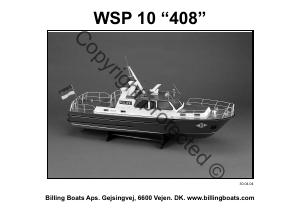

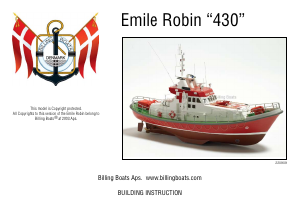


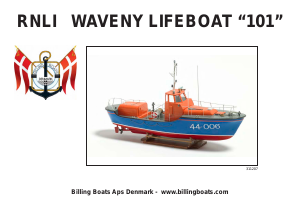
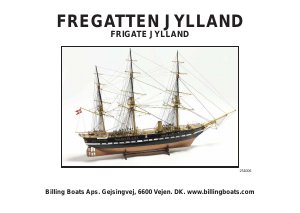
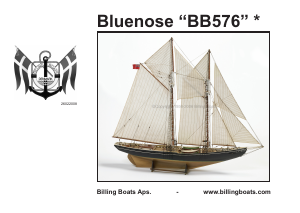
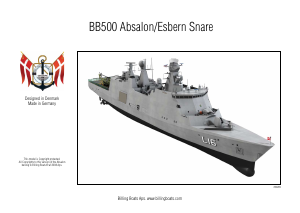
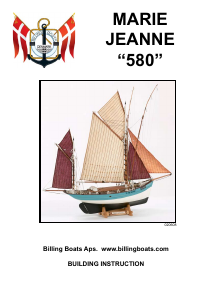
Diskutieren Sie über dieses Produkt mit
Hier können Sie uns Ihre Meinung zu Billing Boats set BB408 Boatkits WSP10 Polizeiboot mitteilen. Wenn Sie eine Frage haben, lesen Sie zunächst das Bedienungsanleitung sorgfältig durch. Die Anforderung eines Bedienungsanleitung kann über unser Kontaktformular erfolgen.